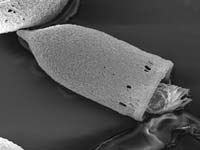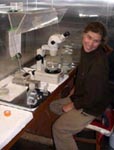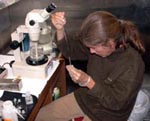Chemical
Signaling and Defense Among Marine Protists |
 |
Funded by NSF
Protists evolved most of the cellular signaling machinery used by multicellular eukaryotes, but we know little about complex behaviors and interactions among most of the environmentally important taxa. Within marine plankton, chemical interactions that deter feeding on specific prey may be common, and may contribute to population- and community-scale processes, affecting trophic structure. This research seeks to contribute to our knowledge of chemical signaling among marine microplankton.
| 1. Current project: amino acid receptor on the ciliate Favella | |
|
Nicole Huber is characterizing a putative amino acid receptor in the marine tintinnid oligotrich ciliate Favella for her master’s thesis work. |
| 2. Inhibition of grazing by marine ciliates and dinoflagellates exposed to micromolar levels of amino acids | |
Suzanne Strom’s
lab has found that the ciliate Favella sharply reduces
grazing in the presence of some amino acids. Grazing reduction appears
to be a function of amino acid side chain, and occurs immediately.
These additions were not lethal, nor did they consistently alter
swimming behavior. Other grazers (dinoflagellates) were affected
to varying degrees. This work was published in Aquatic Microbial
Ecology in May 2007. Posters Presented at ASLO, 2005
|
Click on the thumbnails for full-sized photos. |
| 3. Inhibition of grazing by marine dinoflagellates exposed to micromolar levels of the organic osmolyte dimethylsulfoniopropionate (DMSP) | |
| L&O PDF SEM photos of Amphidinium and others movies |
Michael Steinke and I proposed a model for subacute chemical defense in the haptophyte alga Emiliania huxleyi, a cosmopolitan taxon and the dominant calcifying organism on the planet (The Emiliania huxleyi Home Page). We suggested that enzymatic cleavage of dimethylsulfoniopropionate (DMSP) by DMSP lyase to form acrylate and dimethyl sulfide (DMS) is activated by protist grazers, and found a dinoflagellate taxon (Oxyrrhis marina) fed preferentially on E. huxleyi clones with low lyase activity. BB PDF L&O, Nature PDFs More recent work with Suzanne Strom showed that the original hypothesis did not seem to hold against a spectrum of protist grazers. We found that micromolar DMSP, but not DMS or acrylate, was deterrent, and in addition, when we observed selection against high-DMSP lyase E. huxleyi strains, it appeared to occur without ingestion of prey. |



